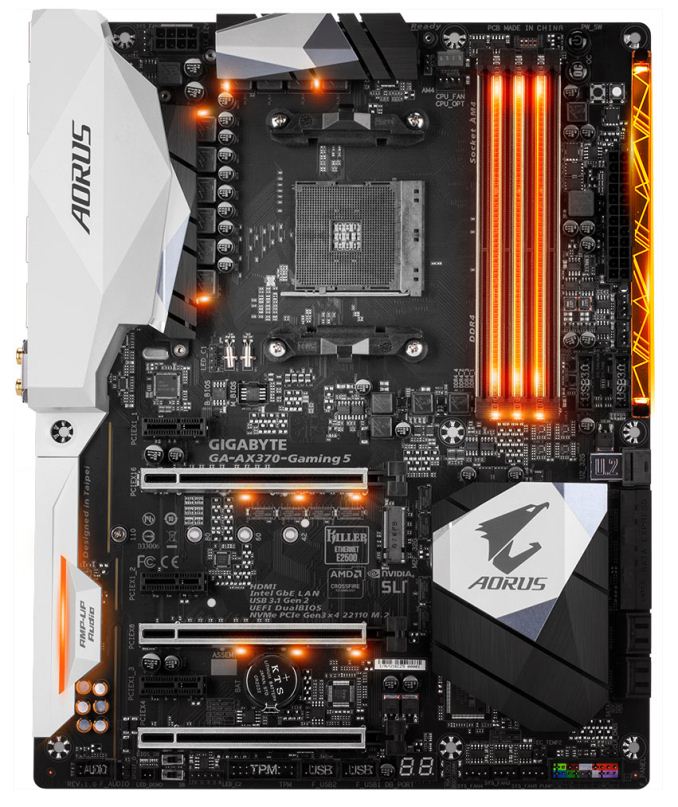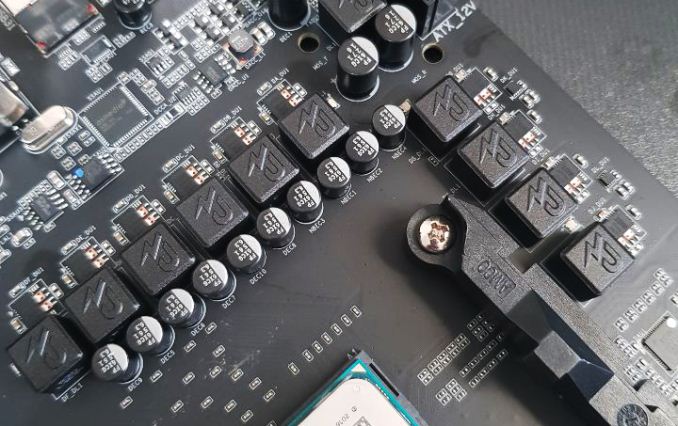The GIGABYTE Aorus AX370-Gaming 5 Review: Dual Audio Codecs
by Gavin Bonshor on November 14, 2017 12:30 PM ESTGIGABYTE Aorus AX370-Gaming 5 Conclusion
The GIGABYTE Aorus AX370-Gaming 5 is primarily designed for gamers that want premium features, but don’t want to break the bank. Priced around $175 at Amazon, it sits at a very competitive pricing point as far as X370 boards go. With a 10-phase power design, SLI and CrossFireX multi-GPU support, this white and black themed RGB laden ATX motherboard offers a nice board for users who want to make the most of the dedicated front panel headphone codec, thanks to the inclusion of a second Realtek ALC1220 codec.
The AX370-Gaming 5 has eight SATA 6Gb/s ports, a single U.2 port and a single centrally located PCIe x4 M.2 slot which supports NVMe and SATA drives up to a maximum of 110mm in length. RAID arrays including RAID 0, 1, and 10 are all supported by the Gaming 5 with all of the eight SATA 6Gb/s ports having the ability to be used. It is worth mentioning that when using the U.2 port, it automatically disables the M.2 slot.
Performance is relative and no abnormalities were found when testing, although I would personally expect a more fluid looking BIOS - nonetheless it is still fully functional and will do the job. Although it seems like GIGABYTE has focused all of the research and design budget on looks and features, users planning on using Bristol Ridge APUs on this board can still make do with a single HDMI 1.4 port. There are plenty of USB ports available including six USB 3.1 Type A ports, as well as USB 3.1 10Gb/s Type-A and Type-C ports.
The power delivery is controlled by the International Rectifier IR35201 digital PWM controller with IR3553M 40A MOSFETs supporting it with a wave of custom GIGABYTE solid ferrite chokes. Overclocking on the GIGABYTE Aorus AX370-Gaming 5 is pretty straightforward, although GIGABYTE hasn’t included an external clock generator meaning that the base clock is automatically set by the BIOS. This isn’t great for overclockers, but for the purpose of usability, it can be construed a good all-around as the only options for overclocking include CPU core speed and memory via a multiplier.
While this board does not have a built-in Wi-Fi adapter, there are two physical gigabyte networking ports, powered by a gaming-focused Killer E2500 NIC (with the new updated software for network prioritization) and the Intel I211-AT Gigabit controller. The board features a total of eight temperature sensors including six onboard probes and two probe headers. Despite the gaming focus, there is also a basic onboard overclockers toolkit which includes a power switch, reset switch, reset CMOS switch and OC button. The board lacks any built-in voltage check points for extreme overclockers, although those users probably wouldn’t consider an X370 motherboard without an external clock generator anyway.
The GIGABYTE Aorus AX370-Gaming 5 offers gamers enough features and software to satisfy the moniker gaming, but aside from multi-GPU support and a gaming network controller, but the board just feels like its lacking something for being the 2nd top X370 AM4 GIGABYTE offering. Nonetheless, for around $175 at Amazon, users will be hard pushed to find such a gaming-focused, RGB splashed, ATX option.












34 Comments
View All Comments
JTDC - Wednesday, November 15, 2017 - link
Thanks. Sorry to hear there are so many apparent limitations on what will work on the second slot. It seems hit or miss based on your experience.mr_tawan - Thursday, November 16, 2017 - link
Is the compatibility issues something to do with this particular board, or the platform as a whole ? I mean I've seen a number of expansion card manufacturer explicitly mentioned that their card only works with, only tested, or at least prefer Intel's.khanov - Thursday, November 16, 2017 - link
It is a good question mr_tawan. I tried to get a straight answer from AMD support, but in the end they said it was likely a driver issue (not true) and the cards aren't supported in Windows 10. As you may know, Windows 10 is the only officially supported version of Windows for the AM4 Ryzen platform.But in fact, each of the cards I mentioned is fully supported in Windows 10, with a compatible driver automatically installed when using them in an intel-based pc. Some of them are older cards with no *official* support from the vendor, but they work just fine. So is it platform-wide? No idea, and I'm not buying another motherboard just to find out. But I would sure like to know!
tiwake - Saturday, November 18, 2017 - link
Keep in mind that gigabyte started off selling these boards advertising ECC memory support. Within the last month they pulled ECC memory support from their advertised products and disabled ECC in a firmware update.Sleazy business practice. One that I can not support.